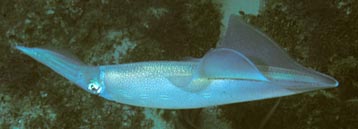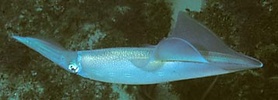Loligo
Inshore squid
Michael Vecchione and Richard E. Young


This tree diagram shows the relationships between several groups of organisms.
The root of the current tree connects the organisms featured in this tree to their containing group and the rest of the Tree of Life. The basal branching point in the tree represents the ancestor of the other groups in the tree. This ancestor diversified over time into several descendent subgroups, which are represented as internal nodes and terminal taxa to the right.

You can click on the root to travel down the Tree of Life all the way to the root of all Life, and you can click on the names of descendent subgroups to travel up the Tree of Life all the way to individual species.
For more information on ToL tree formatting, please see Interpreting the Tree or Classification. To learn more about phylogenetic trees, please visit our Phylogenetic Biology pages.
close boxIntroduction
Loligo species are the common inshore squids of the eastern Atlantic Ocean. Several species are targets of substantial fisheries. Although the biology of some species of Loligo (e.g., L. vulgaris, L. reynaudii ) is among the best known of any cephalopod, considerable controversy remains about their taxonomy and systematic relationships.
The genus is defined by geography and the absence of specific modifications that define other genera.
Brief diagnosis:
A loliginid ...
- with rhomboidal fins in adults, longer than broad (length <70% of ML); mantle elongate; without photophores.
- with an Eastern Atlantic distribution.
Characteristics
- Arms
- Hectocotylus
- Ventral crest absent.
- Proximal suckers unmodified.
- Modified suckers of reduced size and sucker stalks elongated to form papillae in either dorsal or both dorsal and ventral series.
- Hectocotylus
- Tentacles
- Tentacular clubs expanded; suckers in four series.
- Tentacular clubs expanded; suckers in four series.
- Mantle
- Elongate, posterior tip blunt.
- Elongate, posterior tip blunt.
- Fins
- Fins in adults rhomboidal and longer than broad, tapering posteriorly.
- Fins extend to posterior tip of mantle.
- Photophores
- Photophores absent.
- Viscera
- Eggs less than 4 mm.
- Spermatophore cement body short.
Comments:
Alloteuthis is morphologically very similar to Loligo. However, molecular analyses by Anderson (2000) indicate that Alloteuthis should be considered a separate genus. This supports earlier inferences by Naef (1921-23) and Alexeyev (1989) that the presence of a gladial conus in Alloteuthis should be considered a generic character. The conus in Alloteuthis would clearly separate the genera but it can be very difficult to find and in some Alloteuthis specimens may be reduced until it is essentially absent. The posterior tip of the mantle in Alloteuthis is elongate into a tail-like structure that tends to be more pointed than in Loligo. This is particularly true for males but identification of this character state can be subjective in females.
Nomenclature
According to Lesueur (1821), use of the name "loligo" for squids can be traced to the classical Roman philosopher, Pliny (lib. IV, cap. XIX; see also Naef, 1923:197). Linnaeus established Sepia loligo in 1758 to encompass all cephalopods with a cylindrical body and fins (Hoyle, 1910:410). Subsequently, squids in general were often referred to as "loligos" (e.g. Lesueur, 1821). Many authors have interpreted Schneider's (1784) use of the name "Loligo" (capitalized and not preceded by a generic name) as the establishment of the genus Loligo. However, Hemming (1954) showed that Loligo Schneider, 1784 resulted from a misinterpretation of Schneider's work. Schneider's intent was to remove Nautilus Linnaeus, 1758 and Argonauta Linnaeus, 1758 from the univalve molluscs and to include them with all other cephalopods in a new genus, Octopodia. Thus, Schneider actually proposed the new combination Octopodia loligo but did not follow the convention of always using the generic name and not capitalizing the species. Loligo was then formally described by Lamarck in 1798 to distinguish four squid species, L. vulgaris, L. subulata, L. sagittata and L. sepiola from the octopods (for which he erected the genus Octopus Lamarck, 1798) and from the cuttlefishes of the genus Sepia.
The only other squid genera that predate 1821 are Onychoteuthis Lichtenstein, 1818, which was established to distinguish cephalopods in which hooks replace some of the suckers on the arms or tentacles, and Cranchia Leach, 1817, a very unusual squid.
Discussion of Phylogenetic Relationships
Except for geographic distribution, Loligo species are unified in their lack of the characters distinctive of some other genera (photophores, spermatophore with long cement body, large eggs, hectocotylus with ventral crest, etc.). The most distinct of the three species is L. forbesi. The southern African species, L. reynaudii, is very similar to L. vulgaris and , based on electrophoresis, Augustyn and Grant (1988) concluded that L. reynaudii should be considered a subspecies of L. vulgaris. However, L. reynaudii and L. vulgaris are allopatric and distinct morphologically; we consider them to be distinct species.
Distribution
Loligo includes species of the eastern Atlantic Ocean and forms a nearly continuous distribution from southern Africa to 60°N.
References
Anderson, F.E. 2000. Phylogeny and historical biogeography of the loliginid squids (Mollusca: Cephalopoda) based on mitochondrial DNA sequence data. Molecular Phylogenetics and Evolution 15: 191-214.
Alexeyev, D.O. 1989. Advantages and limitations of using the gladius in diagnosis of species and genera of the family Loliginidae (Cephalopoda). Zoologichesky Zhurnal, 68(6):36-42.
Augustyn, C.J. and W.S> Grant. 1988. Biochemical and morphological systematics of Loligo vulgaris vulgaris Lamarck and Loligo vulgaris reynaudii d'Orbigny nov. comb. (Cepahlopoda; Myopsida) Malacologia 29(1):215-233.
Brakoniecki, T.F. 1986. A Generic Revision of the Family Loliginidae (Cephalopoda; Myopsida) Based Primarily on the Comparative Morphology of the Hectocotylus. Ph.D.
Dissertation, University of Miami, Miami, FL, USA. 163 pages.
Brierley, A.S., and J.P. Thorp. 1994. Biochemical genetic evidence supporting the taxonomic separation of Loligo gahi from the genus Loligo. Antarctic Science, 6(2):143-148.
Naef, A. 1921-1923. Die Cephalopoden. Fauna e Flora del Golfo di Napoli, Monographie 35, Vol I, Parts I and II, Systematik, pp 1-863.
Vecchione, M., T. F. Brakoniecki, Y. Natsukari and R. T. Hanlon. 1998. A provisional generic classification of the family Loliginidae. Smithson. Contr. Zool., 586.
Vecchione, M., E. Shea, S. Bussarawit, F. Anderson, D. Alexeyev, C.-C. Lu, T. Okutani, M. Roeleveld, C. Chotiyaputta, C. Roper, E. Jorgensen and N. Sukramongkol. 2005. Systematics of Indo-West Pacific loliginids. Phuket Mar. Biol. Cent. Res. Bull. 66: 23-26.
About This Page

National Museum of Natural History, Washington, D. C. , USA

University of Hawaii, Honolulu, HI, USA
Correspondence regarding this page should be directed to Michael Vecchione at
Page copyright © 2018
 Page: Tree of Life
Loligo . Inshore squid.
Authored by
Michael Vecchione and Richard E. Young.
The TEXT of this page is licensed under the
Creative Commons Attribution-NonCommercial License - Version 3.0. Note that images and other media
featured on this page are each governed by their own license, and they may or may not be available
for reuse. Click on an image or a media link to access the media data window, which provides the
relevant licensing information. For the general terms and conditions of ToL material reuse and
redistribution, please see the Tree of Life Copyright
Policies.
Page: Tree of Life
Loligo . Inshore squid.
Authored by
Michael Vecchione and Richard E. Young.
The TEXT of this page is licensed under the
Creative Commons Attribution-NonCommercial License - Version 3.0. Note that images and other media
featured on this page are each governed by their own license, and they may or may not be available
for reuse. Click on an image or a media link to access the media data window, which provides the
relevant licensing information. For the general terms and conditions of ToL material reuse and
redistribution, please see the Tree of Life Copyright
Policies.
- Content changed 02 September 2010
Citing this page:
Vecchione, Michael and Richard E. Young. 2010. Loligo . Inshore squid. Version 02 September 2010 (under construction). http://tolweb.org/Loligo/19858/2010.09.02 in The Tree of Life Web Project, http://tolweb.org/









 Go to quick links
Go to quick search
Go to navigation for this section of the ToL site
Go to detailed links for the ToL site
Go to quick links
Go to quick search
Go to navigation for this section of the ToL site
Go to detailed links for the ToL site